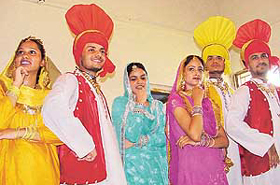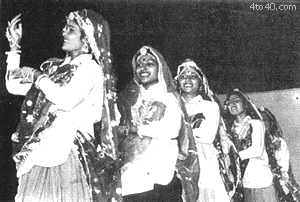Jhummar
Originally a Baluchi tribal dance this dance has come from Sandalbar (now in Pakistan), but is now very much a part of Punjab folk heritage. It is a dance of graceful gait, based on specific Jhumar rhythm. The Jhummar is a dance of ecstasy. It is a living testimony of the happiness of men. Any time is Jhummar time especially during Melas, weddings and other major functions and celebrations. Performed almost exclusively by men, it is a common sight to see three generations - father, son and grandson - dancing all together. There are three main types of jhummar, each of which has a different mood, and is therefore suited to different occasions.
The costumes are the same as that of the Bhangra.
It is danced to the tune of emotional songs. The dance is without acrobatics. The dancers dance around a single drummer who stands in the center. The movement of the arms only is considered the dance's main forte. The dancers', usually men, feet are moved forwards and then backwards while turning to the left and to the right to the beat of the singers and drummer, sometimes the dancers place their left hand below the ribs on their left hip as they gesticulate with their raised right hands while circling the drummer in a wide circle keeping up a soft, sibilant chorus as they dance. The dancers of this dance let-off a sound, "dee dee" in tune with the beat of the dance which adds to its grace. This dance has also been integrated into Bhangra.
This dance does not tire out its performers and it is normally danced on moonlit nights in the villages away from the houses and homes. Today it is danced mostly by tribal Sikh professional acrobats having not yet being adopted by all Punjabis.
We did some minor research on where Jhumar is currently being practised, as Jhumar seems to have almost dissappeared. Luckily Phokhar Singh from the punjab and his class are the ones who are now promoting the dance in the Punjab.
After the partition of the Panjab most of the practioners of Jumar ended up in Pakistan, but Phokhar Singh learned Jhumar from his uncle and has been dancing it since childhood. Nowhe has started teaching the dance to students at D.A.V college, Jalalabad, Punjab. His octogenarian bones may be a little stiff but as you can see in the video he's still dancing.
We would like to see other colleges adopt Jhumar the way they have adopted Bhangra and Gudda forming competing college teams. If you are aware of any college which has a Jhumar Team, let us know we would like to see some photo graphs here.
The Tribune's video link to the story on Phokar Singh and the Jumar[1]
| Dances of Punjab and beyond |
|
Bhangra -|- Giddha -|- Kikli -|- Luddi -|- Jhumar -|- Dhankara -|- Sammi -|- Teeyan -|- Jaago -|- Jalli -|- Dhumall -|- Malwai Giddha |



